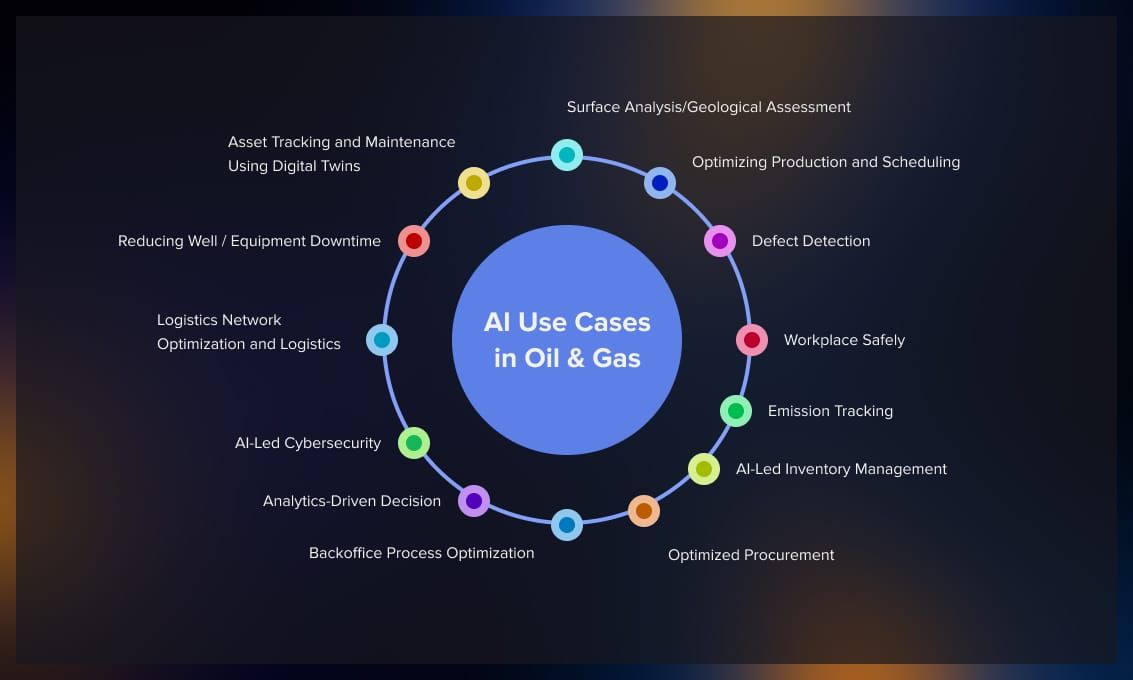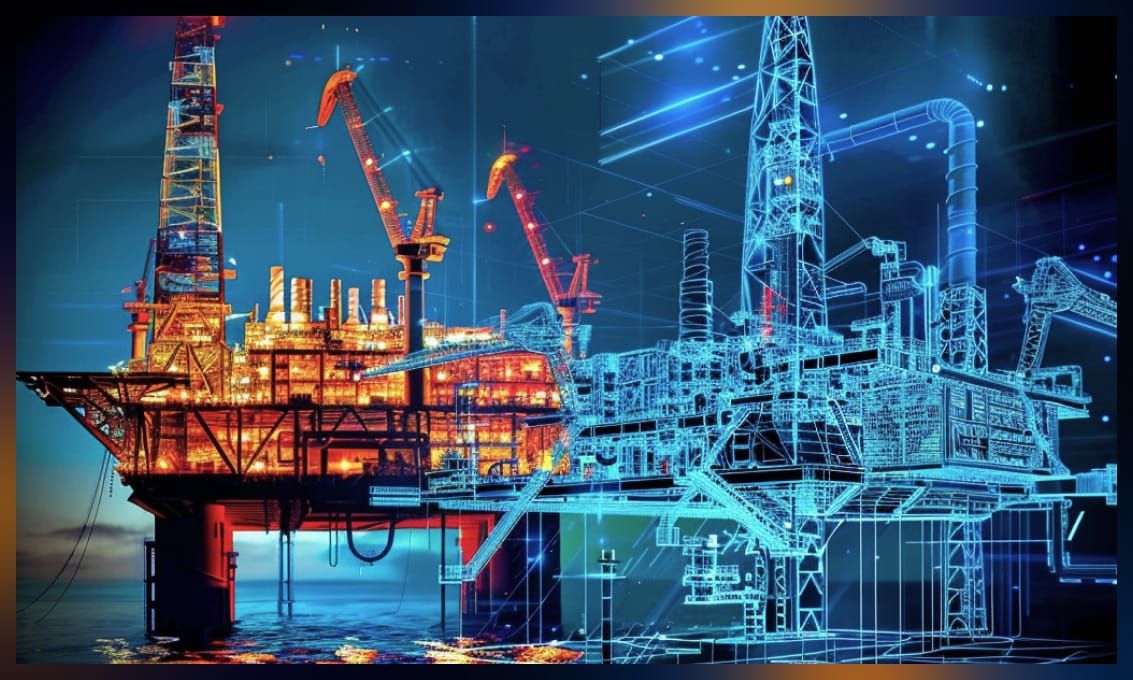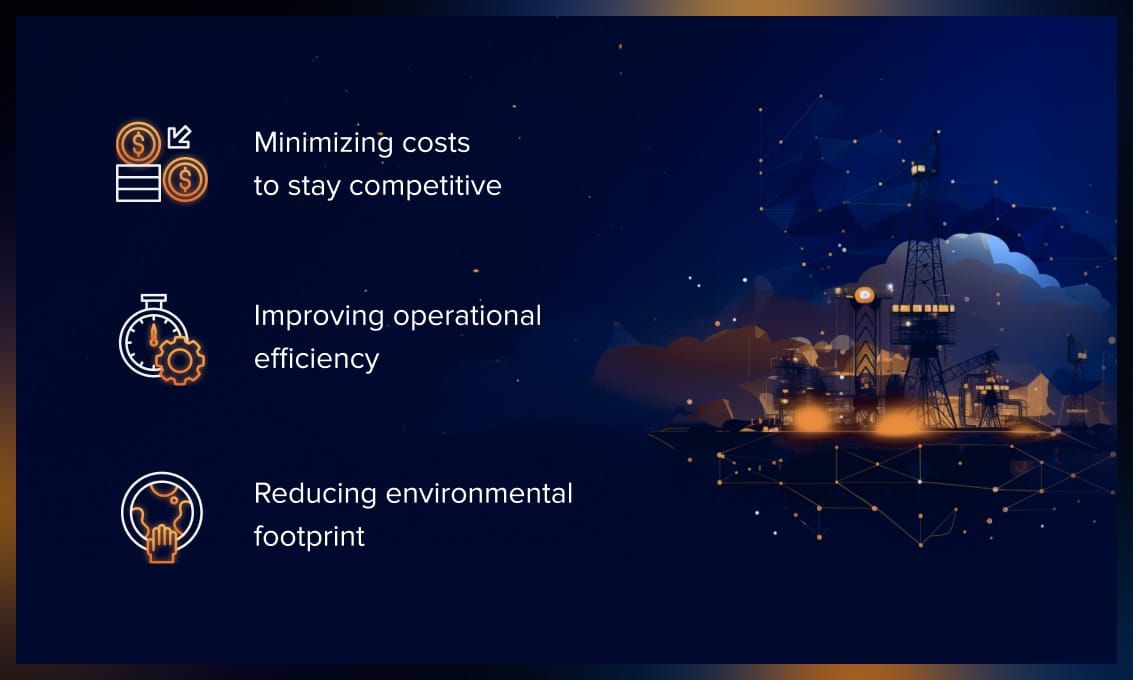With the global energy demand escalating, companies in the oil and gas field face growing demands to boost operational efficiency, cut expenses, and adhere to safety and environmental regulations. AI has emerged as a crucial solution to meet these demands. Over the last ten years, the integration of artificial intelligence into the oil and gas sector has significantly transformed the industry.
In this article, we will explore the market dynamics of AI in the oil and gas industry, focusing on major trends, driving factors, challenges, and opportunities.
The technological state of the oil and gas industry in 2024
In 2024, the oil and gas industry is increasingly shaped by the introduction of AI and the growing trend for sustainability.
A report by MIT Technology Review and Siemens Energy titled “Transforming the Energy Industry with AI” provides several case studies on how AI is rapidly changing the oil and gas industry.
For example, Abu Dhabi National Oil Company (ADNOC) leverages AI to significantly improve planning, scheduling, and safety, reducing maintenance costs by 20%. Before integrating digital solutions, ADNOC’s production planning was cumbersome and time-consuming, involving numerous Excel spreadsheets. The company transformed this process by creating digital twins of all assets and plants, enabling rapid scenario analysis and decision-making. This digital transition has allowed ADNOC to extend the maintenance cycles of key equipment like turbines and pumps, reflecting these updates in their maintenance policies.
Chevron, for its part, focuses on integrating AI across various operations, from petrotechnical applications to cybersecurity. The company is also committed to environmental conservation, utilizing advanced deep learning techniques in computer vision and bioacoustics for wildlife protection projects.
The application of AI in the oil and gas sector is expected to expand in the upcoming years. A recent survey by EY revealed that over 92% of global oil and gas firms are either already investing in AI or intend to do so in the short-term perspective. Here are some key statistics by the research agency Future Market Insights:
- The AI market in the oil and gas sector is projected to see a growth rate (CAGR) of 14.1%, reaching a valuation of US$ 13 billion by 2034.
- The solution segment is expected to lead the global market, with a projected CAGR of 13.8% from 2024 to 2034.
- Forecasted to propel the global market in 2024, the upstream segment is anticipated to grow at a CAGR of 13.6%.
- Experts predict that the AI market for the oil and gas industry in the United States will grow at an annual rate of 14.5% through to the year 2034.
The main drivers behind this growth are related to the need for enhanced operational efficiency and the need to stay abreast of the technologically advanced competitors.
- Operational efficiency and cost reduction: AI technologies, like machine learning and data analytics, help optimize production and identify cost-saving opportunities.
- Enhanced safety and environmental sustainability: AI assists in risk identification and mitigation, aiming to lower accidents and reduce emissions and waste.
- Data utilization: The availability of vast sensor data enhances decision-making and operational improvements through AI analysis and prognosis.
- Competitive investment: Both established corporations and startups are heavily investing in AI to innovate solutions specifically for the oil and gas industry, which increases competition in the market.
Key trends of AI adoption in oil and gas
The major areas where AI finds an increasing application among the leaders of the oil and gas industry include:
- Predictive maintenance: The use of AI algorithms for predictive maintenance is on the rise, aimed at preventing equipment failures and minimizing downtime.
- Digital twins: This technology creates virtual models of physical assets, facilitates real-time monitoring and simulation of operations.
- Edge computing: There’s an increasing shift towards edge computing, which processes data directly at its source (like offshore platforms) to decrease latency and enhance real-time decision-making.
- Partnerships with technology leaders: Large-scale oil and gas enterprises are forming alliances with tech giants and AI startups, tapping into advanced AI technologies and specialized knowledge.
We will take a closer look at each trend in the following sections.

Trend 1. Predictive maintenance
AI-driven predictive maintenance involves using artificial intelligence technologies to forecast equipment failures, optimizing maintenance schedules, and reducing operational downtime. This approach contrasts with traditional reactive maintenance, which responds to equipment failures after they happen, or preventive maintenance, which follows a predetermined schedule regardless of actual equipment condition.
Core components
- Data collection: Sensors installed on equipment collect real-time data on operational parameters such as temperature, pressure, vibration, and flow rates.
- Data integration: This data is integrated with historical maintenance records, operational data, and the markers of environmental conditions to create a comprehensive dataset.
- Machine learning models: ML models analyze the data to identify patterns, anomalies, and recognize trends.
- Predictive analytics: The system predicts potential equipment failures and suggests optimal maintenance schedules based on the analysis.
Trend 2. Digital twins in the oil and gas industry
Digital twins in oil and gas are virtual representations of physical assets, processes, or systems used in exploration, extraction, processing, and distribution. They allow for more informed decision-making, optimizing operations, and driving innovations while mitigating risks.
This technology leverages data analytics, machine learning, and simulation to create a dynamic digital replica of physical entities. These replicas can operate parallel to their real-world counterparts, providing real-time monitoring, analysis, and prediction.

Design and development
In the design and development phase, digital twins can simulate the behavior of infrastructure or equipment under various conditions. Making necessary adjustments before physical assets are built or deployed allows for proactive risk reduction, control of equipment vulnerabilities, and resources optimization.
Operational efficiency
By simulating the operations of oil and gas processes, digital twins can help identify bottlenecks, optimize workflows, and reduce operational costs. This includes everything from drilling and extraction to transportation and refining processes.
Risk management
Digital twins play a significant role in risk management by predicting the outcomes of potential hazardous events, such as equipment failures, leaks, or environmental impacts. This enables companies to mitigate risks proactively and ensure safety and compliance with regulations.
Innovation and experimentation
Digital twins can help companies experiment with new methods for exploration, extraction, and processing without the associated risks and costs of physical testing by simulating and testing scenarios in a virtual environment.
Training and development
Digital twins offer a realistic and interactive platform for training employees on complex oil and gas operations without the need for physical presence, which can enhance safety and efficiency.
Trends 3. Edge computing in oil and gas
Edge computing means the deployment of data processing equipment closer to the source of data generation, such as at remote drilling sites, offshore platforms, or along pipelines. This contrasts with cloud computing, where data is processed at distant data centers.

Real-time data processing
In remote or offshore operations, connectivity can be limited or unreliable. Edge computing enables processing vast amounts of data generated by sensors and equipment directly at the source. This facilitates real-time monitoring and analysis of critical operational parameters like pressure, temperature, and flow rates.
Safety and environmental monitoring
Edge computing enables the real-time monitoring of environmental conditions and detecting hazardous situations, such as gas leaks or structural failures. Quick local data processing ensures immediate alerts and responses, significantly enhancing safety protocols and environmental protection measures.
Operational optimization
By processing data locally, companies can optimize operations in real time, adjusting drilling parameters, production rates, and resource allocation based on immediate feedback from the edge. This leads to more efficient resource use, optimized production, and reduced operational costs.
Bandwidth and connectivity savings
Transmitting large volumes of data from remote sites to centralized data centers requires significant bandwidth and can incur high costs. Edge computing decreases the need for data transmission, reducing bandwidth requirements and connectivity costs.
Enhanced security
Edge computing also enhances data security by processing sensitive information locally.
Implementation considerations
Implementing edge computing in the oil and gas industry requires addressing challenges such as ensuring the reliability and robustness of edge computing devices in harsh environments, managing the deployment and maintenance of these systems, and integrating edge computing into existing IT and operational technology infrastructures.
Trend 4. Strategic partnerships between oil and gas and tech companies

Large-scale oil and gas enterprises increasingly collaborate with technology leaders, including tech giants and AI startups. These partnerships aim to enhance exploration, safety, production efficiency, as well as sustainability in the oil and gas sector.
Shell
Shell has partnered with Microsoft to accelerate its digital transformation and innovation in energy efficiency and carbon emissions reduction. This strategic alliance involves using AI and other digital tools to support Shell’s business, from exploration and production to the distribution of energy and products. Microsoft’s cloud services, AI capabilities, and IoT solutions play an essential role in optimizing the oil company’s operations and enabling more sustainable energy solutions.
Shell has 160 active AI-driven projects across its oil and gas supply chain. Examples include exploration and drilling programs which use reinforcement learning techniques to minimize gas extraction expenses. Shell’s automated drilling systems, which are trained using proprietary and simulated data, support drill operators by providing a deeper understanding of the underground environment.
Moreover, in response to the growing electric vehicle (EV) market, Shell’s RechargePlus program employs AI to forecast the fluctuating demand for EV charging stations, ensuring energy is supplied more efficiently. Additionally, in Singapore and Thailand, Shell uses computer vision technology at its retail stations to detect unsafe behaviors, such as smoking near pumps or during refueling, allowing staff to promptly shut down pumps to prevent accidents.
BP
BP has formed a significant partnership with Microsoft since 2017, adopting Azure cloud solutions and machine learning to enhance drilling efficiency. This collaboration has enabled BP to centralize its data centers on Azure, streamlining data analysis and decision-making, which has led to a substantial reduction in drilling times. In 2020, BP also partnered with Bluware in the field of deep learning, aiming to simplify the interpretation of subsurface data, a process traditionally marked by manual labor and extensive time investment.
BP’s investment in AI extends to several companies, including Grid Edge and Belmont Technologies. Grid Edge offers an AI-powered energy management platform that optimizes energy profiles for buildings, while Belmont Technologies provides industrial AI software for critical operational insights, process automation, and optimization. Other notable investments include Beyond Limits and Satelytics, with AI applications ranging from locating oil and gas reserves to environmental monitoring and risk management.
BP has also explored other uses of AI, such as deploying the Spot robot in refineries to collect data, detect abnormalities, and monitor emissions, reducing human exposure to hazardous conditions.
ExxonMobil
ExxonMobil is another industry leader leveraging AI. The company collaborates with IBM’s Data Science and AI Elite Team and seismic experts to enhance data integration and interpretation. This has resulted in a unified data repository hosted on a multi-cloud environment. ExxonMobil’s partnership with Fiserv introduces voice-activated payments at gas stations using Alexa and Echo Auto, processed via Amazon Pay. Moreover, in collaboration with MIT’s AI lab, ExxonMobil is developing AI-driven, self-learning submersible robots for ocean exploration.
Halliburton
Halliburton is a leader in the application of artificial intelligence for oil exploration. The company’s AI-based DS365.ai software enhances various aspects of oil exploration, from subsurface analysis to drilling and production. In 2022, Halliburton teamed up with the Saudi Data and Artificial Intelligence Authority (SDAIA) to design advanced solutions using the DS365.ai software. Moreover, Halliburton’s LOGIX Autonomous Drilling Platform leverages AI and ML to optimize the performance of mature brownfield oil wells.
What are the challenges of AI implementation?
Despite the significant potential of AI in the oil and gas industry, its implementation faces several challenges:
- Data quality: Ensuring data quality and consistency is crucial for AI applications. Flaws in data can lead to inaccurate insights and wrong decisions.
- Legacy systems compatibility: Many oil and gas companies operate on legacy systems that may not seamlessly integrate with advanced AI technologies. Upgrading or replacing these systems while maintaining operational continuity can be a significant challenge.
- Initial investment costs: Adopting AI technology requires large-scale investments in technology, infrastructure, and a skilled workforce.
- Talent shortage: There’s a notable lack of professionals with AI expertise specific to the oil and gas industry, making it difficult to secure and maintain a qualified workforce.
- Regulatory compliance: The gas and oil industry is highly regulated, and AI implementation must comply with strict industry standards and government regulations. Ensuring that AI solutions adhere to these regulations can be a complex process.
Sustainability
Many oil and gas companies are actively seeking to reduce their carbon footprint and make their operations greener, and AI comes to the forefront in these endeavors. One example is the partnership between the US oil and gas company Occidental Petroleum and the Canadian startup Carbon Engineering, who are setting up a facility designed to capture and store half a million metric tons of CO₂ every year.
This is driven not only by environmental concerns but also by growing trend among investors to support environmental programs in the industry. For instance, Climate Action 100+, an initiative launched in 2017 and dedicated to ensuring corporations address climate concerns, has over 700 participants who collectively manage assets exceeding $68 trillion. Similarly, governments are prioritizing sustainable investments as central components of their economic recovery plans.
Furthermore, research by the Boston Consulting Group highlights the significant potential of AI in enhancing corporate sustainability. It says that by 2030, the use of AI could generate between $1.3 and $2.6 trillion in value through new revenue streams and cost savings.
The statistics above suggest that companies not adopting new approaches today may risk falling behind tomorrow. To improve their financial stability and reputation, and to capitalize on the shift towards a low-carbon future, they need to transform their operations through the integration of AI.
Conclusion
In conclusion, the integration of artificial intelligence into the oil and gas industry represents a pivotal shift towards addressing the complex challenges of today’s energy landscape. AI not only offers the tools to significantly enhance operational efficiency, extend equipment life, and reduce costs but also plays a critical role in ensuring safety and environmental compliance. As the industry continues to evolve, embracing AI technologies will be crucial for companies seeking to remain competitive in an increasingly demanding and dynamic global market.



.jpg)


.jpg)
.jpg)